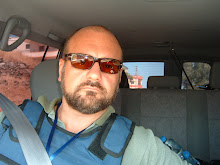 I have decided to write few articles about the Risk Security Assessment I conducted in Colombia in January – February 2007 for two reasons: first of all, I visited eleven towns in the country so it would be too reductive summarize such an interesting mission in few lines, secondly the general security context is very complex and deserves a fairly deep explanation.
I have decided to write few articles about the Risk Security Assessment I conducted in Colombia in January – February 2007 for two reasons: first of all, I visited eleven towns in the country so it would be too reductive summarize such an interesting mission in few lines, secondly the general security context is very complex and deserves a fairly deep explanation.My task was to conduct an evaluation of the risk both at Bogota country office and at each field office location level, performing RSA and thus providing recommendations about how to improve security measures according with the MOSS (Minimum Operating Standard Security).
For obvious confidential reasons I cannot provide details of such mission, besides it would be very boring for readers. Far more interesting is reading these posts as considerations made by a traveler who knows about security.
Let’s start then describing the general security context in Colombia.
Everybody knows that Marxist guerrilla groups began their insurgency in the early 1960s. An estimated 10,000 rebels remain active in various areas. The largest is the Revolutionary Armed Forces of Colombia (FARC), followed by the National Liberation Army (ELN) and a splinter group of the Popular Liberation Army (EPL). The former right-wing paramilitary groups number an estimated 5,000 to 7,000, were accused of widespread human rights abuses. Few years ago the Colombian government came out with a plan intended to offer to criminal groups an interesting package to stimulate them to leave their illegal activities through a special rehabilitation program (providing jobs, offering salaries etc). The program did not work as expected. In fact, some of them came back to their illicit activities adopting the name of Black Eagles (Aguila Negra), others took apparently advantage of the government offer, but started in parallel then their own local criminal gang, only few returned to legality. Both former paramilitaries and guerrillas rely on the cocaine business to finance their operations.
Colombia is widely regarded as one of the main drug producing countries of the world and a major distribution route. Drug money is used for political and criminal assassinations and for political acceptability, and clashes between guerrilla groups and the army, police and drug gangs, are almost daily occurrences within Colombia. Travel to areas reported to grow and process drugs represents a high risk to personal safety.
Illegal armed groups are accused of deliberately displacing civilians, often to benefit wealthy patrons.
These Internal Displaced People are assisted by the international community through International Organizations, NGOs, etc.
Statistically Colombia is quoted as the country with the highest rate of violent deaths in the world. These are committed every 20 minutes bringing the total to 45,000 per year of which 97% remain unsolved. 61% of all kidnappings, are also carried out in Colombia.
This was the context in which I conducted my RSA.

Ecuadorean soldiers carried away the bodies of Colombian guerrillas killed by the Colombian military during a raid of a rebel camp in Ecuador. The raid set off a diplomatic crisis. Courtesy NY Times.
Bogota’ was for me a real surprise. A very nice town modern and developed. The main threat in Bogotá area remains that of local crime (robbery, credit card cloning etc). The security in general has improved lately thanks to an agreement promoted by the Government, between the Armed Forces, Police and private security companies. Such document promote a better cooperation of the security forces on the ground, giving to thousand private security operators same prerogative as police only when an emergency takes place. In practical terms the number of security “eyes” on the Bogota’ streets tripled. The number of attempted kidnappings and crime related events and dramatically reduced.
 Two suburbs of the town are considered “critical” from a crime stand point: Soacha and Ciudad Bolivar. In these two areas is high the presence of IDPs who left their homes located probably in rural areas, forced by guerrilla to leave. They relocated in very precarious conditions in the nearby of large cities, including Bogota.
Two suburbs of the town are considered “critical” from a crime stand point: Soacha and Ciudad Bolivar. In these two areas is high the presence of IDPs who left their homes located probably in rural areas, forced by guerrilla to leave. They relocated in very precarious conditions in the nearby of large cities, including Bogota.Just a couple of practical suggestions for those travelling in town, besides the basic security precautions that anybody must adopt when out of home country. When catching a taxi be sure that it belongs to a known “certified” company. Furthermore, as soon as the taxi arrives, pretend to make a call (fake) to somebody saying loudly to wait for you, and that you are arriving with the taxi plated (mention the plate). You could even ask ID card to the driver, if he refuses call another (certified) taxi.
Don’t take the risk to travel between cities in Colombia by car. The car could be attacked in isolated areas. Better fly, flight tickets are generally cheap and the service on board of the Avianca, the national flight company, is very good.
Enjoy Bogota’ its people, its pure Latin brilliant night life, its food and tradition.
















2 comments:
Hello Generoso. Please send me your gmail address, then I can send you the invitation to my "lifestory" blog.
Hi Peter, email rocsecuritynet@gmail.com
Thanks for the invitation!
Post a Comment